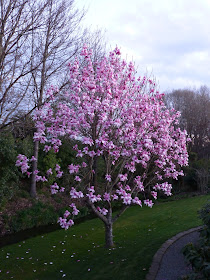Everyone recognises the daffodil as being a major
element of spring garden displays. Magnolias are just as important in the
spring garden and make a fine show once established. A drive around any town or
city in NZ will enable the keen observer to spot many different magnolias
flowering from early spring to late spring.
One of the most important magnolias is Magnolia
campbellii, but there are others equally important depending upon the effect
gardeners are looking for. These include M kobus, M stellata, M x Soulangiana,
M wilsonii and M seiboldii.
Magnolias belong to a large, varied genus of 125
species of deciduous and evergreen trees and shrubs from east Asia and the
Americas was named after French botanist Pierre Magnol. The leaves are usually
oval and smooth edged. Known for their elegant flowers and their distinctive
character, magnolias are a showy group of shrubs and trees. The large
spectacular flowers are generally large, fragrant and solitary with colours including
white, yellow, pink or purple, and may be shaped like a funnel, cup, saucer or
star.
Magnolias require deep, fertile, well-drained and
aerated, mildly acid soil. The fleshy roots are fragile so the plants do not
transplant readily. They thrive in sun or part shade but need protection from
strong winds. The flower buds are frost sensitive. Branch structure and
developing flower buds add interest in winter. Some magnolias flower when they
are 2 or 3 years old and others take 10 or even 20 years to come into flower.
They are well worth the wait.
M campbellii
This deciduous Himalayan species eventually grows 24 m
tall with a 12 m wide crown in the right conditions and there are a few this
size in NZ but usually they are a lot smaller. Its slightly fragrant flowers
are up to 25cm in diameter and appear on leafless branches from late winter to
mid-spring. Plants raised from seed may take from 6 - 20 years to flower. It is
reliably hardy. Today there are some really good NZ raised cultivars and
hybrids to choose from. ‘Alba’ has pure white flowers; ‘Charles Raffill’ is
white and rose purple; ‘Lanarth’ is a deeper rose purple. Magnolia ‘Vulcan’
with dark red flowers.
M.kobus
Deciduous and conical, this Japanese species can reach
10 m tall although it is not often seen this big in cultivation. Its aromatic
leaves are 20 cm long and mid-green in colour.
The flowers are produced in early spring before the foliage and have
long, narrow petals sometimes stained pink at the base. It can be seen planted
as a street tree around Christchurch.
M. stellata (star magnolia)
This many-branched, compact, deciduous shrub from
Japan grows 3 m tall and wide, with aromatic bark when young, and narrow dark
green leaves. Fragrant, starlike, pure white flowers, 8 -12 cm wide, open from
silky buds in late winter and early spring but its flowers are sometimes
damaged by sudden frost. It flowers when quite young, and has several cultivars
in shades of pink, including ‘Rosea’, ‘Waterlily’, the most prolific flowerer,
has more petal and slightly larger white flowers. Though the shrub’s floral
display is enchanting, its wonderful open form would recommend it even if it
failed to bloom.
M soulangiana
This deciduous hybrid between Magnolia denudata and M.
liliiflora first appeared in Europe in the 1820s and is now represented by many
cultivars. It is an erect tree 8 m tall and 4.5 m wide, usually single trunked.
The dark green leaves are tapered at the base at rounded at the tip, with a
short point. Blooms in goblet, cup and saucer shapes and in white, pink or deep
purple-pink appear from late winter to mid-spring, before and after the leaves
emerge. ‘Alexandrina’ flowers are pure white inside, flushed rose pink outside.
Goblet-shaped cultivars include ‘Lennei’, beetroot purple outside, white to
pale purple inside; ‘Lennei Alba’ with pure white flowers; and ‘Rustica Rubra’,
rose red outside and pink and whit inside.
M wilsonii and M seiboldii
From China, these spreading, deciduous shrubs or small
trees grow up to 6 m high and wide. In late spring and early summer fragrant
cup-shaped yellow flowers with red or magenta stamens hang from arching
branches among narrow dark green leaves that arc velvety be h. These smallish
trees represents a group of deciduous summer flowering species from China, with
pendent flowers distinguishing them from the upright ones of the better know
spring-flowering species. The white blooms are beautifully fragrant.
Magnolia roots arc
fleshy and fragile so transplant carefully in spring. Container-grown plants
are the best. Look for well-branched plants. Plant them in a fairly shallow
hole - just deep enough to cover the roots - but give them enough space for the
roots to develop horizontally, and leave enough space for the free in its
mature size.
Provide generous
water until established, and then taper off to watering during dry spells. Most
well-established shrubs growing in a good garden loam can easily tolerate a
week or two without water. The frequency of watering and quantity of water will
be determined by a number of factors, including soil characteristics and
exposure. If the soil is not naturally rich, provide an annual application of
organic mulch. Provide generous fertiliser until plants are established.
Some species of
magnolia arc attacked by scale. If not controlled carefully, it can cover the
plant. The tree is usually able to repel any diseases if properly sited and
growing vigorously. Prune magnolias as specimen ornamental trees. To avoid
water shoots, any summer pruning should be very light. Remove dead wood
anytime.
Magnolias make
such a fantastic display that all gardeners should find a home for at least one
of the fabulous plants.





He estado buscando en la web en busca de algunas ideas sobre la manera de conseguir mi sitio web personal codificada, su diseño general y el estilo y el estilo son fantásticos. ¿Realmente el código que tu mismo o te iciste un programador para hacerlo para usted?http://www.healthcaresups.com/spartagen-xt-exposed/
ReplyDelete